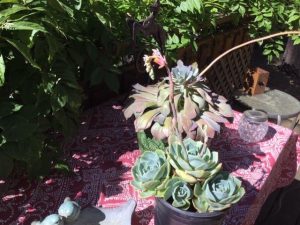Usually, there are two types in the display. One type you completely steer away from because your spidey sense says stay away. The other type calls to you like a siren from the seas. You want to touch the smooth, plump flesh. The textures and colors are mesmerizing.
The term succulent comes from the description of a plant that stores water in its leaves. The Latin word succus means juicy. There are plants from every corner of the world that have thick, moisture filled leaves. Cactus, agave, and aloes are succulents. Better known and touchable succulents are hens and chicks (Sempervivum), jade plants (Crassula ovata), and stone crops (Sedums).
Succulents are popular plants for many reasons. They have interesting textures, colors, and are easy to grow inside and outside. They are a plant that will appreciate you forgetting to water. Succulents only want a drink when they are dry, not every Tuesday at 3:00. When you think about your succulents compare them to little camels. They enjoy a drink but will hate to be soggy. It is best to give them enough to keep their leaves plump and then let the soil dry out between waterings.
Succulents demand drainage. The usual potting soil will hold moisture too long for succulents to be happy. When looking for soil for your succulents’ shop for soil for cactus or succulents. That soil should have perlite, coarse or builder’s sand, and peat moss. This type of soil will quickly drain and prevent rot. Use the soil test to confirm that the consistency is correct. Squeeze a handful of moist soil in your fist then open your hand. The soil should fall apart and not hold its shape. This is the opposite for most plants that love the moisture. For your succulents, a soil that drains well is the key.
Succulents are from dry climates but not from the Sahara Desert. They enjoy light and direct sunlight that is not baking in the summer. Most succulents will change colors when the sun is too intense. Too little light will find your plants reaching for more.
After discovering succulents, you will quickly find that one is not enough. The remedy is easy. Succulents may be propagated with ease. Propagation occurs two easy ways: by a cutting or by a leaf. If you have one that has gotten leggy with a stem that is curled or lying over it may be restarted by cutting off the upper part. Cut it at the bottom where the leaves stop, leaving an inch of stem. Let it cure or dry for a couple of days then place it on top of moist soil. Like magic, the new roots will start growing in a couple of weeks and you will have a new plant. The same with a leaf cutting: snap a leaf off at the stem and let it dry. Then just lay it on moist soil. Poof – a new plant! Remember, no snapping without asking.
Several easy and reliable succulents to try are; Paddle or Flapjack plant (Kalanchoe thyrsiflora), Tree Aeonium (Aeonium arboretum), Donkey’s Tail (Sedum morganianum) and Hens and Chicks (Sempervivum). All of these plants are easy to start and interesting to watch grow. The Paddle or Flapjack plant has huge leaves that look like flapjacks. Tree aeonium has rosettes of leaves in colors ranging from green to almost black. In the spring they produce cone shaped stems with bright yellow flowers. Donkey’s Tail is just that, hanging stems that look like a donkey’s tail. Hens and Chicks are rosettes that have smaller rosettes growing along the sides.
With the right care succulents will get you the award of Green Thumbs for Great Gardening. Tough and easy plants will fill your house with a variety of little camels.
Julie Silva is a University of California Cooperative Extension Master Gardener of Tuolumne County.


